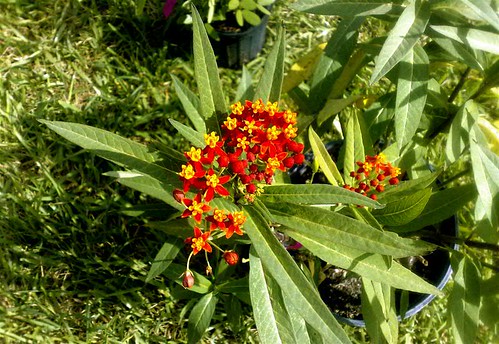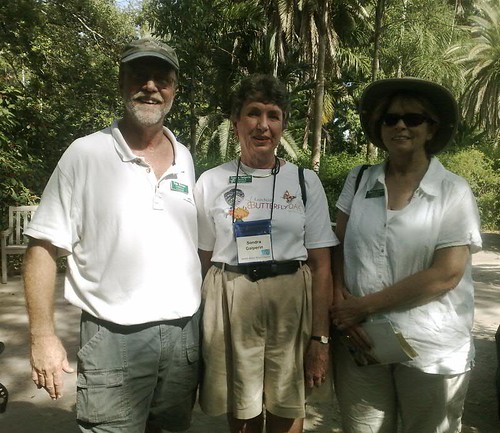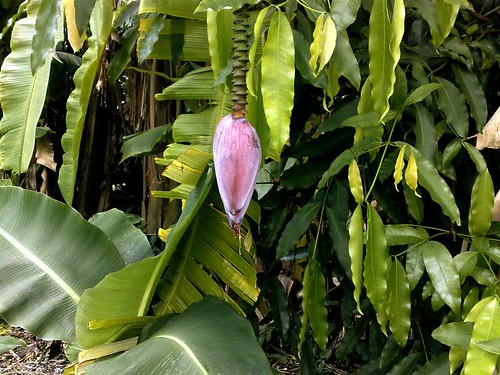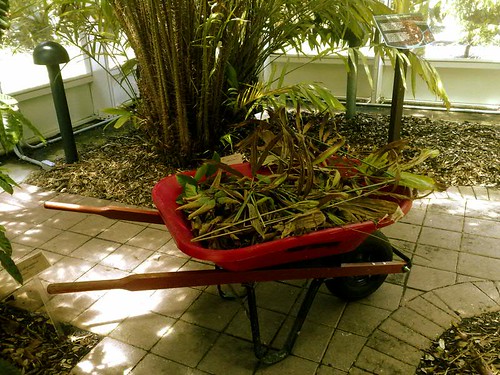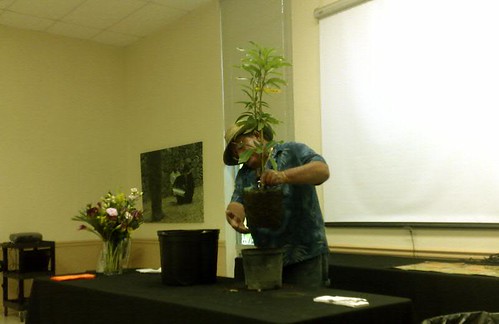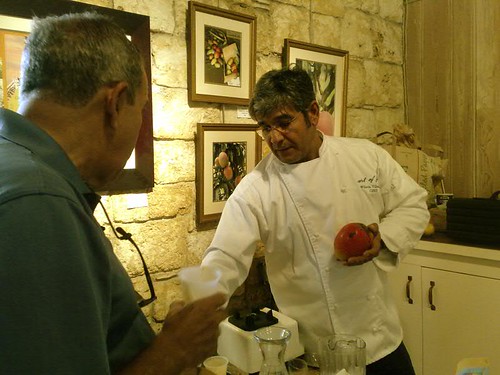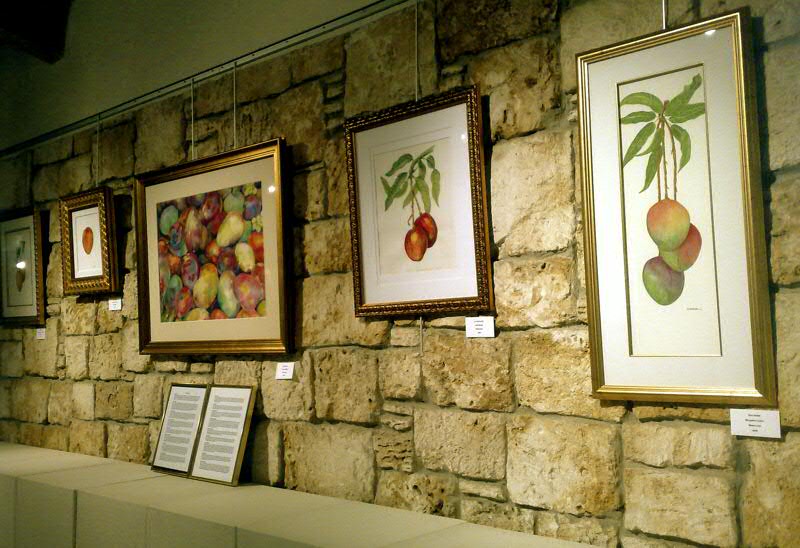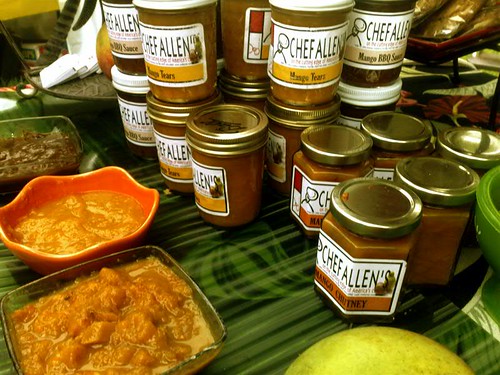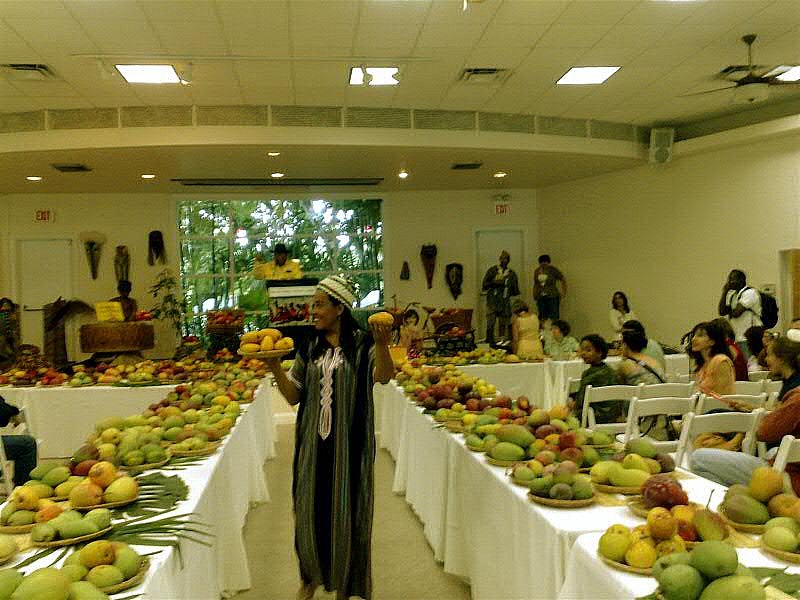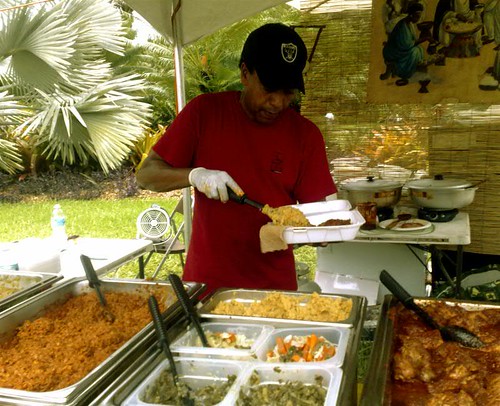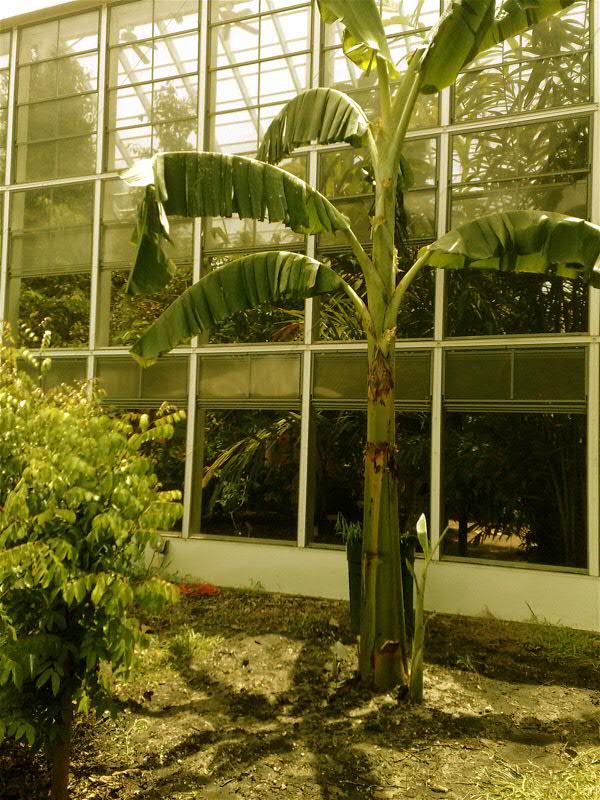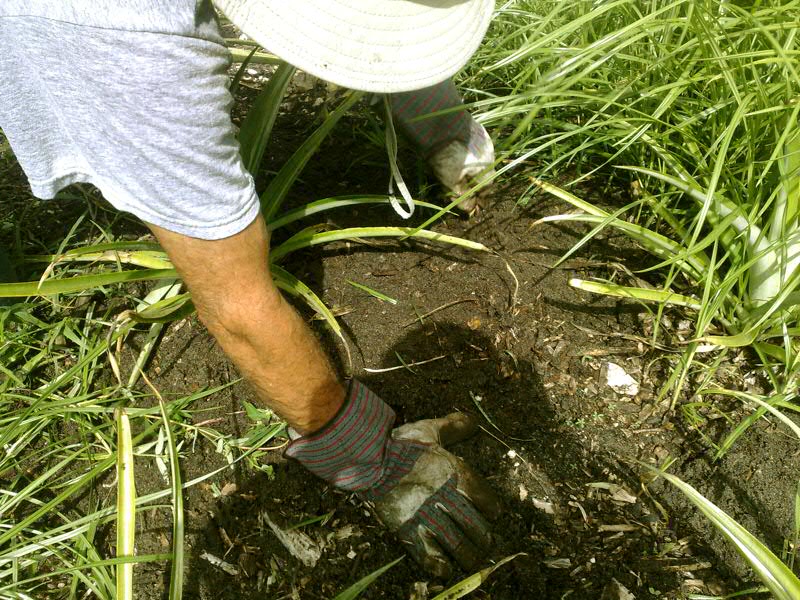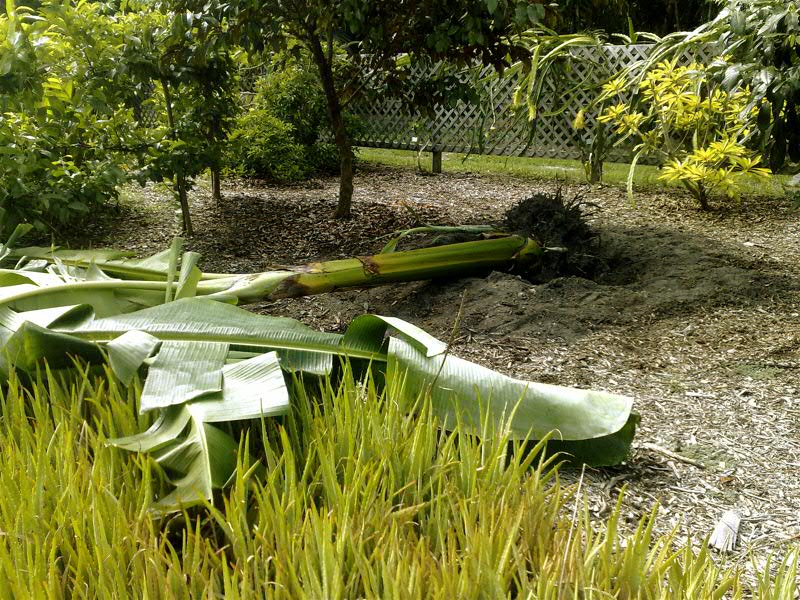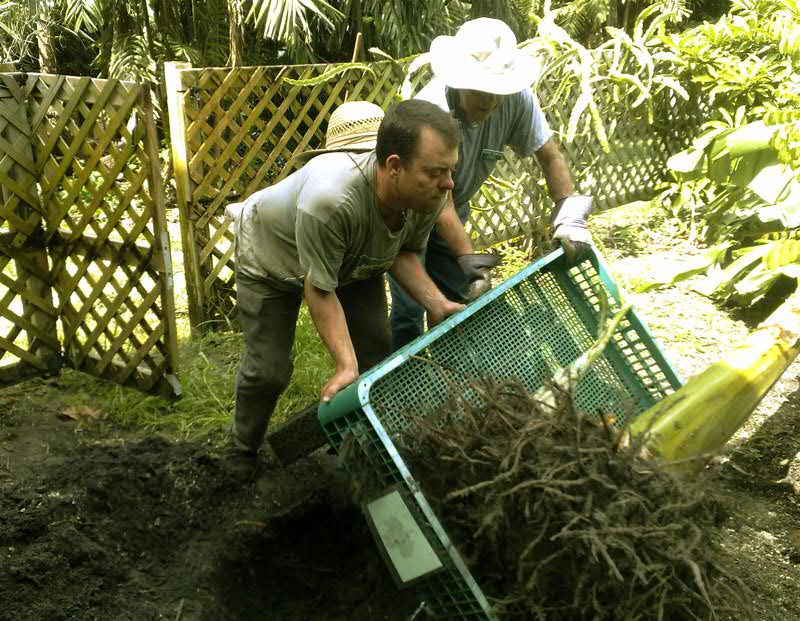July 29, 2008
Mangrove Love
A friend of mine told me that I reminded him of Honey Santana in Carl Hiassen's novel Nature Girl and even though I wasn't kayaking in the Ten Thousand Islands, I was bitten by quite a few mosquitoes during this impromptu adventure. (Nature Girl is a splendid, funny novel written by Carl Hiaasen, which my fellow writer Matt Meltzer just reviewed over at 411.)
Matheson Hammock is a Miami-Dade county park located right next to Fairchild. It has beachfront, mangrove and hardwood hammock environments. After 4:30 pm (wink, wink) you can drive straight through to the end -- where Biscayne Bay meets land's end -- without paying admission.
So there are no excuses! Get your butt out there to enjoy the heat -- bugs and all. There's nothing like being bitten by the real Florida bug: the one that makes you fall in love with this place!
If you are interested in learning more about mangroves, stop by my friend Xavier Cortada's Reclamation Project.
FREE Sundays

No excuses folks! Event though it's hot as hell, come on over to Fairchild August through September. Sundays are free! What a treat!
My suggestion is that you come early, take the tram tour and then walk whatever areas of the garden you like. Plenty of them offer shade. Give yourself at least two hours to stroll all the different areas. Keep in mind, the Garden Café serves wonderful sandwiches and refreshing, fruity soft drinks, so you can do lunch after all that walking.
Fairchild's Visitor Information page has all the details.
If you come in the afternoon, stop by Matheson Hammock park next door when you're done. It's free after 4:30 PM. As you drive down the path, you'll pass a mangrove area and then end up at the water's edge on Biscayne Bay. A stroll around the atoll pool, with views of downtown Miami, Key Biscayne and Miami Beach in the horizon, is a splendid way to enjoy a breezy Miami sunset.
PS ... if you go, come back here and tell me you fell in love with this beautiful part of Miami.
July 27, 2008
Butterfly Days
update Aug 4: a new Miami Blue butterfly photo added below, courtesy of Jaret C. Daniels.
I didn't volunteer this week because Jon-Mario was going to be out on Friday and my car had to go to the shop. But I did stop by for a few hours on Saturday to see what I could learn during Butterfly Days, a two-day event dedicated to these beautiful creatures and the gardening that supports them.
I really don't know a heck of a lot about butterflies, but it seems like for those who are into it, there's quite a bit to learn. Many years ago, I lived in a cottage with a beautiful garden. I planted a passion flower vine that promptly became the nourishment of many caterpillars. I observed the process from beginning to end -- as they gobbled up the plant and then formed a chrysalis. One morning, all of the butterflies had burst out and were flying around me. It was a very special moment and one I'll not soon forget.
I caught two lectures on Saturday. If there's one thing I learned, it's that butterfly gardening requires balance. If you simply want to attract adult butterflies, plant nectar host plants so that they can feed. But if you want to support the entire lifecycle, also plant larval hosts so that females can lay eggs and caterpillars can eat. Maintaining the right number of plants seems to be the key ... and part of the fun!
BUTTERFLY GARDEN BASICS
Cindy David, a very entertaining and enthusiastic lecturer from the Florida Chapter of North American Butterfly Association, talked about Butterfly Gardens 101. She said something that stuck in my mind: "Butterflies are flying flowers." I had never thought of them that way, but it's true -- their delicate wings are like moving petals.
Here are some of Cindy's recommendations for host plants to attract many different kinds of butterflies:
- monarch and queen - milkweed
- julia, fritillary and zebra - passion vine varieties (passiflora), including Florida native, Corky Stem (passiflora suberosa)
- atala - coontie
- sulphur - cassia and senna
- east black swallowtail - dill, parsley and fennel
- swallowtail - wild lime (as a substitute for citrus)
Again, it's all about balance.
And speaking of, the great thing about butterfly gardening is that it requires the use of native plants, which means your garden can support the local ecosystem. Some of the plants, like Firebush (hamelia patens), also attract hummingbirds to their nectar and other avian species to their seeds. You can learn more about gardening with native plants from the Dade Chapter of the Florida Native Plant Society.
THE MIAMI BLUE
My favorite part of Butterfly Days was learning about a rare and fascinating little creature -- no bigger than a nickel -- called the Miami Blue. This native Florida butterfly used to thrive on the east and west coasts of Florida, as well as the Keys and the Dry Tortugas. Urban development and mosquito spraying, as well as the devastating impact of Hurricane Andrew in 1992, led to declining populations. At one point, many scientists believed the Miami Blue was extinct. It wasn't until 1999 that a butterfly enthusiast spotted Miami Blue at Bahia Honda State Park.
Jaret C. Daniels, Ph.D. of the University of Florida gave a lecture about the Miami Blue. Jaret is an Assistant Professor of Entomology and Nematology at the university's Institute of Food and Agricultural Sciences. He also leads a Miami Blue captive propagation program at the McGuire Center for Lepidoptera Research in Gainesville.
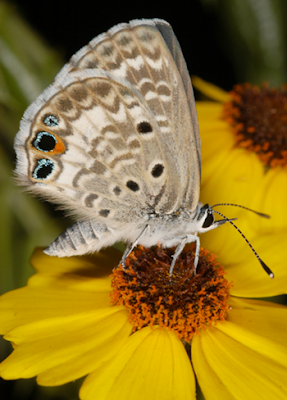 A female Miami Blue is not as blue as her male counterpart. What distinguishes Miami Blue from similar butterflies is the white band underneath the black and blue spots. Photo courtesy of Jaret C. Daniels.
A female Miami Blue is not as blue as her male counterpart. What distinguishes Miami Blue from similar butterflies is the white band underneath the black and blue spots. Photo courtesy of Jaret C. Daniels.Here are some notes from the lecture:
- The Miami Blue population at Bahia Honda likes living near the beach and it feeds on Gray Nickerbean (Caesalpinia bonduc).
- Miami Blue larvae have a symbiotic relationship with ants. Larvae secrete a sugary substance from special organs on their backs, which ants consume. In return, ants protect larvae from predators and parasites.
- Hurricane Andrew had a devastating impact on the already declining population of Miami Blues. The hurricane season of '05 also affected populations. The loss of coastal habitat during a storm is the main culprit.
- The captive propagation program has produced over 30,000 viable organisms since 2003. A Q-tip, soaked in Gatorade as a substitute for nectar, feeds the adults. Between 2004-07, about 5,000 butterflies were introduced into the environment.
- In 2006, a population of Miami Blues was discovered at Boca Grande Key (Key West National Wildlife Refuge).
- The best place to spot the Miami Blue and many other butterflies is Bahia Honda State Park.
TOUR THE GARDEN
Here is an impromptu video I shot on my cellphone of the butterfly garden this weekend. Enjoy! Click through to YouTube so you can see the video in high-quality mode and also read my annotations.
Profile: Volunteers
Left to right: Tom Privett, Sandra Galperin and Shary Privett.
Husband and wife team Tom and Shary Privett have been volunteering at Fairchild for one year and a couple of months, respectively. Tom gives tours of the butterfly garden on Saturdays while Shary has gotten involved in education. A former attorney, Tom is now a full-time school teacher.
Sandra Galperin has been volunteering at Fairchild for about 3 years. She has worked in the herbarium, as a garden host and with the tea events. She recently carried the olympic torch in San Francisco! The reason? Sandra has also devoted 31 years as a volunteer swim coach at Venetian Pool.
There are nearly 600 volunteers at Fairchild who contribute thousands of hours each year. Become part of the family and stop by this September for the recruitment events.
July 23, 2008
Butterfly Days

Butterfly Days takes place this coming weekend, July 26-27, 9:30 am to 4:30 pm, at the Garden House and lawn.
Come and learn all about butterflies; lots of kids activities, walking tours and educational lectures. Take a butterfly tour through Fairchild with experts, learn to identify South Florida's butterfly species and their native host plants. Also, we will have a one of a kind plant sale, with butterfly plants for your garden.
July 20, 2008
Volunteering - July 18
Jon-Mario told me I didn't have to come in this week since we had put in so much time at the Mango Festival, but I went anyway for an hour or so and cleaned up fallen leaves in the pavilion. It's just good to work up a sweat and be surrounded by plants, which is why I always think the plants are doing more for me than I'm doing for them.
I decided to start a series of profiles here on Fairchild staff and volunteers. Jon-Mario was my first interview. Stay tuned!
July 14, 2008
Mango Festival 2008
 There was something for everyone at this celebration of all things mango. This fruit was part of the auction.
There was something for everyone at this celebration of all things mango. This fruit was part of the auction.I volunteered both Saturday and Sunday during this past weekend's festival. Instead of making smoothies, I ended up helping sell locally grown mangos at the International Fruit Market. The mangos were mainly Tommy Atkins variety from the Williams Grove facility in the Redlands. Other mangos available were the kind I had peeled on Friday -- Champagne mangos from Mexico, Banana mangos from Haiti and Keitt mangos from Puerto Rico.
Here are some highlights from my time at the festival, followed by a slideshow.
COSTUME PARTY
Before the official beginning of the festival, Bohopoetgirl girl and I volunteered at the Mango Safari Costume Party on Friday night. As there was a surplus of volunteers and we had peeled mangos all morning, we were "ordered" to relax and enjoy ourselves -- and that we did! The party was held in the beautiful ballroom on the second floor of the visitor's center, which spills out into a spacious veranda overlooking the garden and one of the lakes.
Bohopoetgirl and I decided this was a good deal: all you can eat buffet with great food (catered by chef Victoria Nodarse and FIU hospitality school students), all you drink bar sponsored by Bacardi, African drum music, DJ and a crowd-pleasing belly dancer made for a fun evening. Tickets for the whole affair were $45 a piece for non-members -- a bargain compared to parking, dinner, drinks and entertainment on South Beach.
We had the opportunity to meet some mango growers at this event. Two were from Peru and the other was from Ghana; the latter gives out interest-free microloans to the poor to spur growth in the economy and create a sustainable mango industry.
CONDO MANGOS
Fairchild was selling small, potted mango trees for $40. I wish I had a yard to plant a tree, but after attending a lecture by Rob Campbell, I learned that growing a fruit-producing tree in a pot is quite doable. Container mango trees need to be in pots at least 25 to 30 inches deep; the tree should grow to about five to six feet tall. A mango tree usually takes four to five years to fruit. Recommended varieties for "condo mangos" include Cogshall, Manalita, Rosigold and Nel Petite.
Here are some tips:
- Use a pot with multiple drain holes
- Avoid overwatering
- Use a soil with good structure -- not too peaty
- Mix soil with silica sand or pine bark
- Put pot on casters and spin the pot around occasionally
- Use about 3 inches of gravel on the bottom of the pot
- Don't bury plant too deeply when repotting
- Use mulch on the top, avoiding the trunk area (malaleuca is good)
- Never use green or cypress mulch
- Select a sunny place
- Never water leaves
- Cover the plant with a sheet (cloth, not plastic) if frost threatens
- Use a slow release fertilizer
MANGO SALAD
Here's a delicious, quick and easy recipe for a Thai Spicy Mango Salad by chef Wilson Villanova, the owner of a boutique catering business called Art of Food (not to be confused with the vegan restaurant in Midtown).
4 cups shredded green mango
4 tbsp diced hot red chili
4 tbsp thinly sliced red onion
4 tbsp rice vinegar
4 tbsp fish sauce
4 tbsp sugar
2 limes
8 tbsp chopped roasted peanuts
8 tbsp dried shrimp
1 small red cabbage
2 sprigs fresh mint (optional)
Step 1 - Dressing: place hot chili, sugar, vinegar and fish sauce in a small bowl. Squeeze the lime into the bowl and mix until the sugar has been dissolved. Set aside.
Step 2 - Place shredded mango in a medium-sized bowl. Add red onions, roasted peanuts and dried shrimp. Pour dressing over the salad and gently toss until ingredients are fully mixed. Serve on individual plates, on a red cabbage leaf and garnish with a sprig of mint. Serves four.
Chef Wilson is a graduate of Johnson & Wales Culinary Arts Program and has over 20 years of culinary and hospitality experience starting in Rio de Janeiro, in his native Brazil, and more recently in Miami. He can be reached at be reached at (305) 345-7339.
MANGO ART
Inside the gallery, paintings that featured mangos were on display. Some of them -- exquisitely detailed watercolors -- were done by students of Fairchild's own adult watercolor class, taught by Donna Torres. One of these days, I'm going to get back into botanical illustration. I took the class once but only produced a small number of paintings and drawings.
YUMMY TO GO
Unbelievably, I only brought one mango -- a Keitt variety from Puerto Rico. (I still have a giant bag of champagne mango seeds to suck the flesh off of at home. My macaw, Samba Jalapeño, goes into absolute rapture when I give her one!)
I did however take home a jar of homemade mango cinnamon jam, which was prepared by volunteers. The jam is usually available, one of volunteers told me, at special events or at the Williams Grove facility on market day.
Chef Allen, famous for his namesake restaurant in Aventura and his use of tropical fruit in gourmet cooking, was there selling his signature sauces and chutney. I liked the mango samples, including a mild mango ketchup, but ironically, it was the Orange-Chipotle "Blasting" Sauce that blew me away.
Schnebly Winery was also selling tropical fruit wines. I tried the Lychee sparkling wine instead of the mango because I wanted something bubbly and really cold to drink in the hot afternoon. The Lychee wine, so redolent of the fruit, but not quite as tart, hit the spot.
MANGO AUCTION
The most interesting part of the festival for me was the auction. Although I didn't bid, I thoroughly enjoyed listening to the energetic and enthusiastic Dr. Campbell share mango trivia before sending the mangos off to bidding. In some cases, Dr. Campbell regaled the audience with tales about where he had collected seeds or how a particular mango came to our shores, as with the case of the Haden, which started mango history in the western hemisphere.
I didn't do an official count, but there must've been at least two hundred varieties of mango from all over the world spread out over the long tables. One bidder paid $575 for half a dozen champagne mangos -- the same kind we had been selling at $1 a piece at the fruit market! Most of the mangos auctioned between $40-$100, each plate offering about 4-10 pieces of fruit. Many of the mangos were grown locally but their seeds had originally come from abroad.
AFRICA
The Mangos from Africa theme extended into music and food; I especially enjoyed listening to the African drummers and the music from a kora, a tall guitar-like instrument. A special treat among the vendors was Kafa, a restaurant that is open for breakfast and lunch in Midtown. I had never tried Ethiopian food and I liked it so much I ordered Alicha Wot -- beef with seasoned butter, garlic, onions, fresh ginger -- on both days. The $8 plate came with a generous serving of delicious red lentils, pickled cabbage with vegetables, teff (pancake-like, spongy bread grown from a grain native to Ethiopa), a slice of another kind of fragrant bread (similar to cornbread) and a dollop of spicy mango sauce. Ironically, Kafa doesn't serve Ethopian food at its restaurant just yet, opting for more traditional American fare. They do plan to offer an Ethopian menu by the end of the summer. Give them a call (305) 438-0114 if you're curious and craving!
Created with Admarket's flickrSLiDR.
July 12, 2008
Mango Peeling and Cutting

In preparation for the mango festival, about a dozen volunteers gathered at the garden early Friday morning to peel and cut about 200 or so mangos. Some of the fruit was to be used for smoothies and some of it for bite-sized samples. Peeling and cutting for smoothies had already been going on in the Redlands at the Williams Grove facility a few weeks prior. Obviously, that fruit was frozen. Over 10,000 visitors were expected for the weekend, so it had to be done.
Peeling and cutting mangos is a very sloppy task, especially with some of the juicier varieties! The best part of the four-hour session, was, of course the opportunity to suck the pulp from the seeds, which is one tastiest experiences a mango lover can enjoy. The "champagne" mango was simply delectable. The scent of mangos filled the classroom building, prompting many staff members to stop by the room with smiles on their faces.
We didn't have to be too fussy about preparing pulp for smoothies, but the fruit samples had to be cut precisely into square shapes. One of the volunteers had the technique down pat. If you're going to slice mangos at home, here's how to do it. Using a flat-edged knife, slice off the rounded edge of the stem point, then peel the mango. From the sliced-off end, cut some longitudinal lines all the way to the bottom of the mango. Follow with latitudinal lines in the desired size. Then simply slice the squares from as close to the seed as possible. Repeat on the second side and cut any remaining flesh off the edges of the seed.
My friend Bohopoetgirl was covered in mango! See fruit-slicing technique at the end of the video.
July 6, 2008
Bromeliad
Portea petropolitana is from South America and belongs to the Bromeliaceae family. This particular specimen grows by the acquatic plant pond next to the gallery. Take a good look next time you're outdoors; currently, many bromeliads are in bloom all over South Florida.
Ghost Orchid in Bloom
They're back! Blooms from the ghost orchid discovered last year at Corkscrew Swamp Sanctuary flowered mid-summer like clockwork.
 In 1844, Belgian plant collector Jean Jules Linden discovered Polyrrhiza lindenii (aka Dendrophylax lindenii) on the island of Cuba. The orchid grows only in Cuba, the Bahamas and South Florida. The plant, which receives nutrients from the air, is nearly impossible to spot unless it's blooming; otherwise it appears as nothing more than a humble tangle of roots attached to a tree. In contrast, the flower dangles delicately, suspended in the air, like a ghostly dancer with widespread arms.
In 1844, Belgian plant collector Jean Jules Linden discovered Polyrrhiza lindenii (aka Dendrophylax lindenii) on the island of Cuba. The orchid grows only in Cuba, the Bahamas and South Florida. The plant, which receives nutrients from the air, is nearly impossible to spot unless it's blooming; otherwise it appears as nothing more than a humble tangle of roots attached to a tree. In contrast, the flower dangles delicately, suspended in the air, like a ghostly dancer with widespread arms.The ghost orchid was the star of Adaptation (2002), a wildly quirky film starring Nicolas Cage, Meryl Streep and Chris Cooper. The latter plays John Laroche, a real-life South Florida jack of all trades who got caught stealing a Polyrrhiza lindenii specimen from the Fakahatchee Strand. Laroche became famous when Susan Orlean published an article in The New Yorker about his Everglades exploits. I wrote a review about Adaptation last year at Miami Beach 411, which made think a great deal about his orchid obsession:
Because they are endangered and so difficult to cultivate, the real-life Laroche was tempted to propagate them [the ghost orchids] himself, putting an end to the black market and in his own twisted altruistic way of thinking—the need for poaching wild specimens.
John Laroche's story reflects a passionate yet sordid twist on the human coveting of these rare plants. Indeed, I am just as fascinated by the technical aspects of pollination today as I was last year when I wrote about Polyrrhiza lindenii:
Our local celebrity ghost orchid has only one pollinator, the giant sphinx moth, whose proboscis is long enough to fit just right, not one millimeter less or more—just right. The slim nectar spur on the bottom is shaped like the long tongue-like appendage of the moth, which can measure up to six inches long. As the moth sucks nectar, sticky grains of pollen attach to its head. For pollination to occur, the moth must visit another orchid where, hopefully, the same pollen will detach onto the plant. The process is a perfect example of adaptation and the unique relationship between the flower and its pollinator.As far as I know, no one has ever successfully propagated the ghost orchid in a laboratory. Still, I think that might be easier than finding love, don't you? Plants have so much to teach us ...
Corkscrew's website reports: "The Ghost Orchid's first 2008 bloom opened June 23, left. By July 1, five blooms were open with three more buds maturing."
Before you rush out west to catch sight of the flowers, keep in mind that the blooms grow far away from the boardwalk. Even the most intrepid photographers need ladders and powerful zoom lenses to capture images of the orchid. But there are many more South Florida natural wonders at this sanctuary, so it's worth a visit.
Read more about the ghost orchid at Corkscrew's website.
Photo courtesy of R.J. Wiley.
Mango Festival 2008
 This year, Fairchild celebrates the mangos of Africa in its 16th annual International Mango Festival. Fairchild's living genetic collection has nearly 400 mango cultivars, making it the largest collection in the world.
This year, Fairchild celebrates the mangos of Africa in its 16th annual International Mango Festival. Fairchild's living genetic collection has nearly 400 mango cultivars, making it the largest collection in the world.The mango came to Africa from Goa by way of the Portuguese traders. It is a staple of life in sub-Saharan households and a source of hard currency from export to Europe. From the green- and yellow-skinned varieties of the land of the Pharaohs, the mango-shaded streets of Accra, and the modern selections of South Africa, the mango has boldly shed its light on the Dark Continent.
Visit the Mango Festival page for more details about the event.
Volunteering - July 3
This week was a physically challenging one but we accomplished so much in three hours. First thing in the morning, while I picked up leaves, Gonzalo finished mulching a small section of the pavilion that we had missed last week.
Afterwards, I spent most of the time weeding some very aggressive grass from the pineapple grove in the orchard, which is right next to the pavilion structure. Gonzalo told me they had planted those pineapples just two months ago.
Note to self: pineapple plants are very prickly! I didn't feel the jagged edges of the leaves very much while I was weeding, but when I got home I saw scratches all over my right arm. Some pure aloe vera gel helped heal the marks quickly.
While I weeded, Jon-Mario and Gonzalo were figuring out how to move a huge banana tree from one part of the orchard to a spot by the pavilion. I can't believe we moved this tree! Obviously, I did none of the major heavy lifting, but I did help steer the gardening cart and hold part of the trunk.
 The two pups growing out of the root ball are called sword suckers, because a) the shape of the leaves and b) they "suck" nutrition from the parent plant.
The two pups growing out of the root ball are called sword suckers, because a) the shape of the leaves and b) they "suck" nutrition from the parent plant.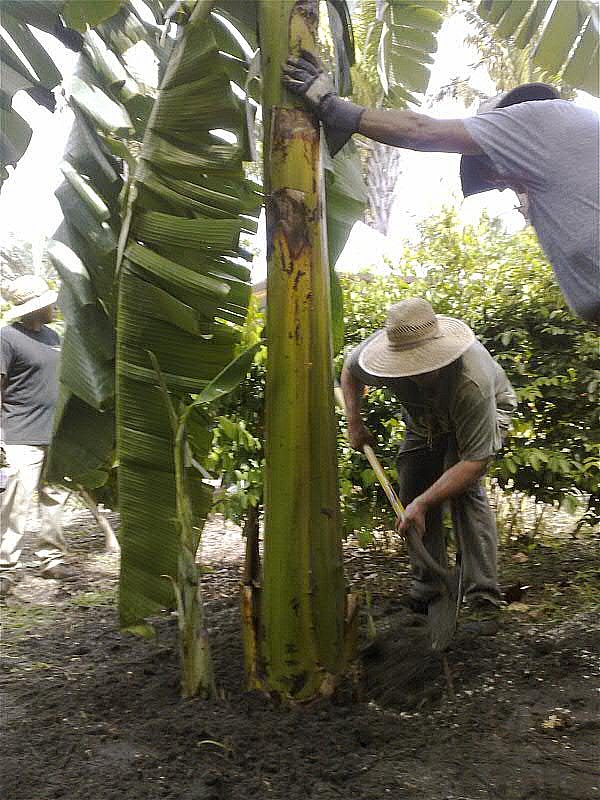 Getting the tree to stand straight and settle into the soil. Maybe I'll eat a banana from this tree some day!
Getting the tree to stand straight and settle into the soil. Maybe I'll eat a banana from this tree some day!All this work was in preparation for the Mango Festival next week. Our final task also had to do with that event; we drove down to the coconut palm grove in the Lowlands to cut some fronds for a tiki hut. The Lowlands is the eastern part of the park, which lies low near a coastal mangrove habitat.



